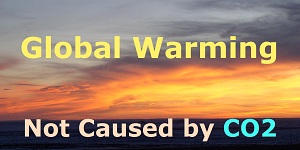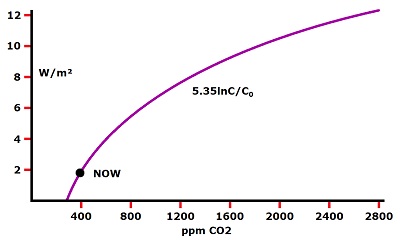|
|
Gary Novak
Saturation, Proof of Climate Science Fraud Fudge Factor for Settled Science
Crunching the Numbers Absorption Spectra Explanations Simple Words Contrivance Communication Corruption Alphabetical Page List And Summaries
The Cause of Ice Ages and Present Climate
|
Contradictions in the Fudge Factor Humans did not create enough supposed temperature increase in the past to point to the amount of temperature increase alarmists want to show for the future. There is no way to get the desired 3-6°C temperature increase upon doubling CO2 in the atmosphere, when humans supposedly increased the temperature by only 0.6°C since the industrial revolution by increasing the CO2 in the atmosphere from 280 ppm to 380 ppm. The fudge factor is used to indicate that a doubling of CO2 in the atmosphere will result in a heat increase of about 4 watts per square meter. This amount is then multiplied by 0.75 to indicate a temperature increase of about 3°C. Not the least fraud is that temperature has no clear and simple relationship to heat, particularly in the unfathomable complexities of climate. Heat increase = 5.35 ln C/C0
Heat is specified as watts per square meter. The atmosphere is three dimensional. Why not a result in terms of cubic meters instead of square meters? Because there is way too much complexity in the three dimensional space of the atmosphere including a pressure gradient, convection, layering, etc. None of that can be accounted for. So the two dimensional result is an abstraction removed from the complex and unanswerable questions. In other words, you get a magical result out of the fudge factor without a complex analysis. That's why it must be called a fudge factor instead of a scientific result. The origin of the fudge factor is sometimes said to be Hansen et al, 1988. But it isn't; it's Myhre et al, 1998. At that time, a 3°C temperature increase was desirable, so the constant 5.35 was used with the natural log of two. How come then the addition of 100 ppm CO2 by humans since the industrial revolution only produced 0.6°C temperature increase? The result should have been 1.2°C (5.35 ln 380/280 x 0.75). As usual, the contrivers missed something which didn't fit their results. Observers would often state that they would be unconcerned about a 1.2°C temperature increase; it would have to be 3-6°C to be worth spending a lot of money on. How do you get the 3-6°C expected result, when the past produced a lot less, for doubling CO2 in the atmosphere? You simply muddle the subject. Rahmstorf stated that the adjustments are made by changing the multiplier for temperature rather than the constant for the fudge factor. Therefore, to get 1°C upon doubling CO2, the multiplier is reduced from 0.75 to 0.27. Multiplying is then done through feedback called forcing. Supposedly, increased heat would cause more water to evaporate, and since water is a stronger greenhouse gas than CO2, the CO2 effect could be multiplied by the increase water vapor effect. To pin down the amount of feedback/forcing, computer models were used, and they provided the rest of the subject of global warming/climate change. To get from the 1.2°C of the fudge factor to the desired 3-6°C temperature increase, the multiplying factor due to water vapor forcing was found to be three. Computer models produced this number. But there's still another glitch (as there always is when contriving to show one and one equals three). If the future 1.2°C is going to be multiplied times a factor of three due to water vapor, why would not the past increase be multiplied by the same factor of three? But of course, it is. The increase in CO2 only increased the temperature by 0.2°C in the past, while water vapor multiplied it to 0.6°C, which is the amount humans supposedly caused based on thermometer measurement analysis of Phil Jones and cohorts. But that fix didn't fix everything either. To get 0.2°C for the past human input out of the fudge factor, the multiplier would have to be 0.12, not the originally stated 0.75. (5.35 ln 380/280 x 0.12 = 0.2) Now the problem is that if this new multiplier (0.12) is applied to the expected doubling of CO2, the end result is 0.46°C temperature increase, not the desired 1.2°C. If the 0.46°C is multiplied times a feedback factor of three, it's only a 1.38°C total temperature increase with forcing. But observers would not be concerned unless it is 3-6°C. In other words, there is no way to get the desired 3-6°C temperature increase upon doubling CO2 in the atmosphere, when humans supposedly increased the temperature by only 0.6°C since the industrial revolution by increasing the CO2 in the atmosphere from 280 ppm to 380 ppm. This contradiction cannot be resolved. Humans did not create enough supposed temperature increase in the past to point to the amount of temperature increase alarmists want to show for the future.
|
||||||||||||
 | |||||||||||||


